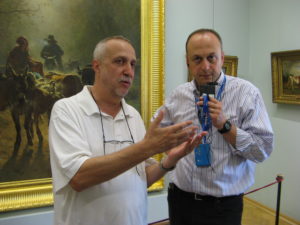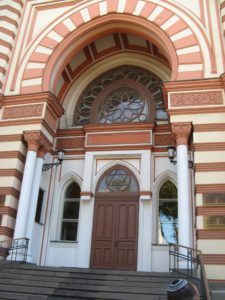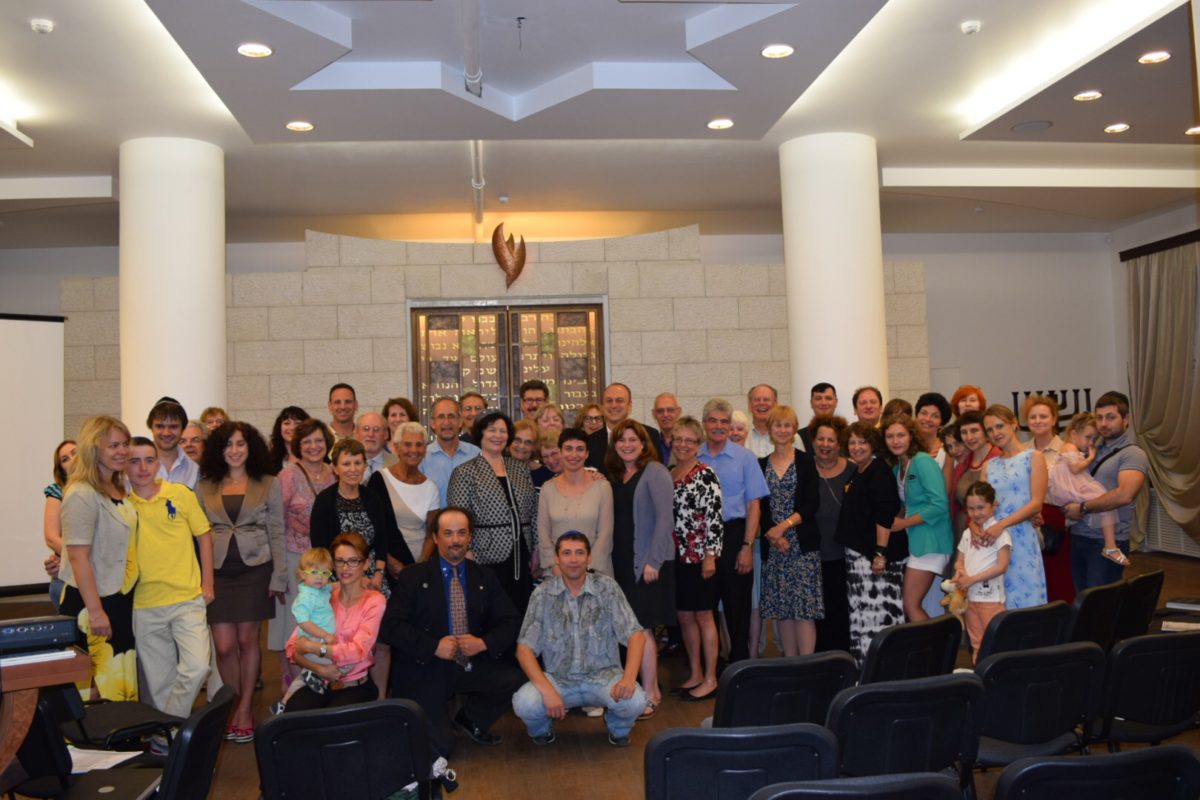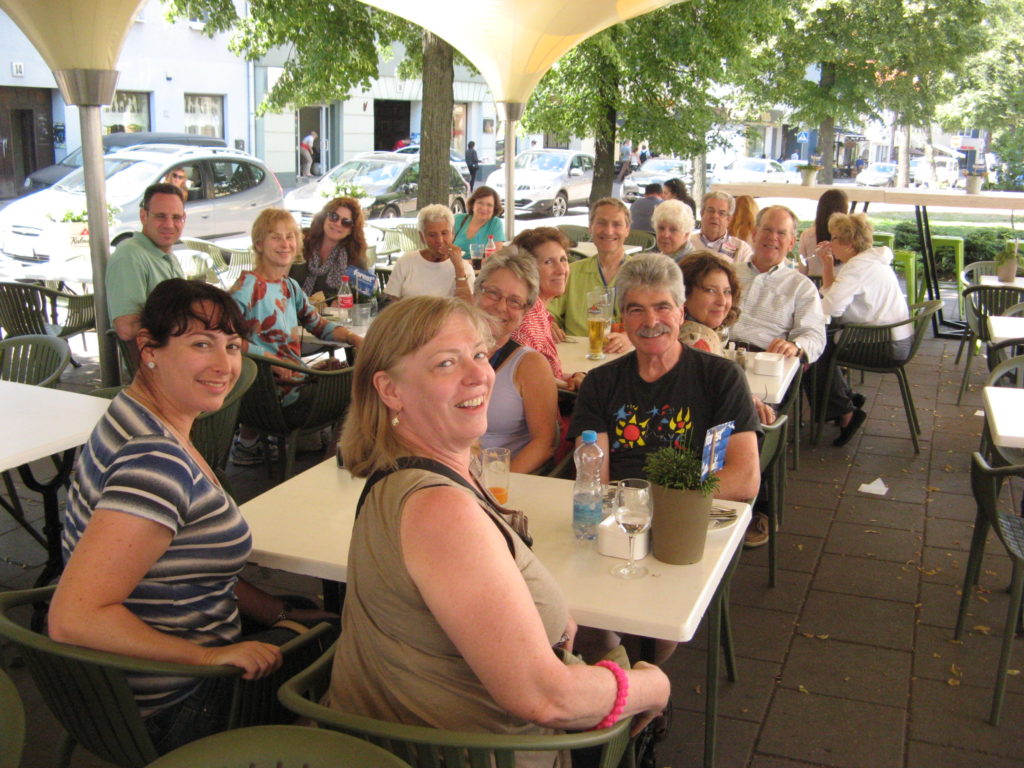From Russia with love
We’re back! Twenty-seven exhausted, happy and deeply impressed travelers left Lithuania on Thursday 7/24. The trip led by Michael Farbman and Olga Marcus included Fran and Steve Grodzinsky, Wendy and Will Sherman, Chris and Monte Radler, Anne and Larry Eisner, Joan and Alan Kliger, Marilyn Fischman, Jo-Anna and Steve Fischman, Rita Brieger, Bess Chosak, Lynne Maser, Naomi and Jessica Klotz, Lee and Peter Stolzman and friends of TE: Ann and Ira Bindman, Paulette Lehrer and Jane Stolzman/Marc Hoffman.
During the three city tour perceptions were challenged, friends were made and an incredible culture was unveiled. Most of us were products of the cold war and expected a Russia that was dull, drab and regulated. Some of us were nervous about being Jews and Americans at a time when relationships were strained. Our identities never seemed to be a factor. As Alan Kliger said, “my unconscious expectation of Russian cities was a dull, grey, Soviet-style architecture ….. The city (St. Petersburg) reminded me more of Paris than of Siberia.”

St. Petersburg was a whirl of both Jewish events and of Russian highlights and history, the days extended by the “white nights” with dark around midnight. The grandeur of the Czars was proudly on display at Peterhof (summer residence of the Czars) and at the Palace of Catherine the Great. Visiting the Hermitage with Rabbi Sasha Lyskovoy (a rabbi/artist friend of Rabbi Farbman) and listening to his discussion of Jewish subjects in the art was special. Our visit to the Museum of the Blockade helped put St. Petersburg’s experience during the 900 day siege in WW2 into perspective. Wandering the streets and seeing the restored buildings and the resilience of the city was impressive. “Beyond the beauty and history of Russia, there was an onion peeling of layers of emotion” Lynne Maser

Our visit to the Jewish Cemetery on day one gave many of us pause. The serenity of the place, the wildness of the growth, the feeling of continuity with the people and the realization that this wasn’t an ancient monument but a functioning cemetery filled us with emotion. We visited the magnificent Choral Synagogue (run by Chabad) and were told it was the only synagogue in St. Petersburg. Our visit to Sha’arei Shalom (the congregation Rabbi Farbman helped build) disproved that. The congregation was alive, energetic, welcoming and very much in existence. To celebrate Shabbat with them was a thrill and to have havdalah on the Neva River in a boat with new friends from the Jewish community was powerful.
And of course we visited Orthodox Churches: Peter and Paul, Kazansky Cathedral, St. Isaac’s Cathedral and theChurch on Spilled Blood. We saw and learned about icons, viewed wonderful frescoes and were overwhelmed by the grandeur. We even managed to attend a ballet (most made it beyond the first intermission and enjoyed it to the end.)
 All this and more! On to Moscow. The fast train was comfortable and offered great views of the flat, unending birch forests. We travelled through one of the most populated corridors in Russia and it seemed empty of people. This is a big country.
All this and more! On to Moscow. The fast train was comfortable and offered great views of the flat, unending birch forests. We travelled through one of the most populated corridors in Russia and it seemed empty of people. This is a big country.
In Moscow the architecture was more soviet style but the city was interesting and welcoming. In our brief visit we went to the Kremlin and saw its collection of churches and offices. Far from the regimented and controlled atmosphere some feared, we jockeyed with tourist groups for camera angles and gathering space. This was a must see for visitors from around the country and around the world.
Red (Beautiful) Square was also an eye opener. Site of military parades and public viewings of missiles for the world to see, we encountered an enclave of history and culture. G.U.M. Department Store with its avenues of growing flowers, Lenin’s tomb, historic office buildings and the spectacular St. Basil’s Cathedral. This iconic picture of Russia with its onion domes and bright colors was worth the visit by itself.
Our stay in Moscow included a visit to the Choral Synagogue (same name, different city). In meeting with its Gabbai we were given a view of the situation of Jews in Russia today. When asked about his feelings for the future given all the changing attitudes during his life, he simply said the future will be what it is and it is today that matters. Honest and profound.
On to our final city, Vilnius in Lithuania. Of all our stops this was the great unknown. We may not have known much about St. Petersburg or Moscow before our visit but we at least had an impression (inaccurate perhaps but something none the less). Vilnius was different, who knew? A small city by comparison, it is compact and laid back. We visited the former Jewish Quarter and stood at the site of the Great Synagogue. You could almost feel the presence of the Vilna Gaon and the vibrant Jewish community. A visit to the Museum of Tolerance gave me goose bumps when our guide, Iga, spoke of her grandmother and father (and others in her family) who have been remembered as Righteous Gentiles for their efforts during the Nazi occupation.
We visited the Paneriai Memorial, site of mass executions, set in the forest outside Vilnius and had a chance to say Kaddish for those whose lives ended there. We went to Trakai Island and were taught about Karaite Judaism. We had a lovely farewell dinner in the former Jewish Quarter.
On our visit to Vilnius University we were privileged to go into the library area of the Yiddish Institute. This beautiful space is devoted to gathering, preserving and teaching Yiddish language and Jewish culture. Students come from around the world to study. It could not be ignored that while the Jewish community was almost destroyed, this center of culture and learning is rebounding. Am Yisrael Chai!
Bess Chosak was grateful for the chance to meet with individual Jewish leaders who are forward looking, hopeful and impressively committed to tikkun olam. Among many impressions from the trip Wendy Sherman had her taste buds reawakened to the spices and flavors of her childhood. There are so many impressions of this trip that it is impossible to isolate one or two. What moved me the most? Was it the cemetery on the first day? The vibrant Jewish Center and community of St. Petersburg? Was it the Gabbai in Moscow or the young woman who went out of her way to lead a group of us to the correct subway train? Was it Iga’s story about her family or being in the Yiddish library? Was it the sign on a St. Petersburg street commemorating a warning to people that that side of the street was dangerous because of the shelling during the 900 days siege during WW2? Or was it being with friends old and new in this communal adventure?
Thank you Rabbi and Olga for sharing all of this and more with us.
Pete Stolzman

